Audi
![]()
This article is about the automobile manufacturer. For other meanings, see Audi (disambiguation).
48.78332811.418035Coordinates: 48° 47′ 0″ N, 11° 25′ 4.9″ E
Audi AG, based in Ingolstadt in Bavaria, is a German car manufacturer that has been part of the Volkswagen Group since the 1960s and has been counted among the premium manufacturers since the 2000s.
The company came into being when August Horch, following disagreements with the financial director, left the A. Horch & Cie. Motorwagenwerke Zwickau, located in the then Kingdom of Saxony, and had to rename his new August Horch Automobilwerke GmbH, because the rights to the "Horch" brand no longer belonged to him after his departure. He found the solution in the suggestion of Heinrich Fikentscher (son of Franz Fikentscher, a friend of August Horch), a high school student from Zwickau, who translated Horch into Latin. Audi is the imperative singular of audire (in German, to hear, to listen) and means "Listen!" or precisely "Horch!". Audi Automobilwerke GmbH Zwickau was entered in the commercial register of the city of Zwickau on April 25, 1910.
In 1928, the small car and motorcycle manufacturer Zschopauer Motorenwerke J. S. Rasmussen AG, known for its DKW brand, took over Audiwerke AG Zwickau. Both companies were merged into Auto Union AG, Chemnitz, which was founded in mid-1932 and which also included Zwickauer Horchwerke AG and the Siegmar vehicle plant of Wanderer-Werke in Schönau near Chemnitz. The merger of the four passenger car brands Audi, DKW, Horch and Wanderer was symbolically expressed in the Auto Union logo with the intertwined rings, today's Audi logo. In the 1930s, the DKW F 1 to F 8 and the two Audi models UW and 225 were among the pioneers of front-wheel drive in Germany.
After the Second World War, a new Auto Union GmbH was founded in Ingolstadt (Bavaria) in 1949. In addition to DKW motorcycles (RT 125 W), fast trucks initially rolled off the production line there, and from 1950 the new Düsseldorf-Derendorf plant built the F 89 passenger car, both models with front-wheel drive. In 1958 Daimler-Benz acquired a majority shareholding in Auto Union and subsequently the Düsseldorf plant produced light Mercedes vans. From 1964, the Volkswagen Group gradually took over Auto Union. Until then, it had only built passenger cars with two-stroke engines under the DKW brand until 1965, when the Audi model with a four-stroke engine was launched under the traditional pre-war brand. In the course of the merger with NSU Motorenwerke, Audi NSU Auto Union AG was formed in 1969. In line with the merger partner, its registered office was Neckarsulm until 1985, when the company was shortened to Audi AG as a result of the discontinuation of the NSU brand and the registered office moved back to Ingolstadt.
Audi AG has owned the sports car manufacturer Lamborghini since 1998 and the motorcycle manufacturer Ducati since 2012.
.jpg)
Radiator grille with Audi emblem Audi quattro (Rallye version, year of manufacture 1983)
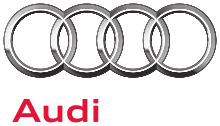
Logo until April 2016
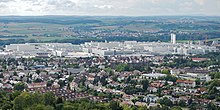
The plant in Neckarsulm. Until 1985, the headquarters of Audi NSU Auto Union AG were also located here.

Audi's headquarters have been located in Ingolstadt since 1985
History
1909-1931: Foundation of Audi Automobilwerke GmbH
The company's history began after August Horch left the company he had founded, "August Horch & Cie Motorwagenwerke Zwickau", and founded "August Horch Automobilwerke GmbH Zwickau" together with Zwickau entrepreneurs on 16 July 1909. Because his former company prohibited him from continuing to use the name Horch for the new automobile factory, it was renamed "Audi Automobilwerke GmbH Zwickau" on April 25, 1910.
In July 1910, the first Audi brand vehicle left the Zwickau plant, which was transformed into a stock corporation, "Audiwerke AG Zwickau", in 1915. During the Great Depression, Audi ran into financial difficulties in 1928. In the same year, the Zschopauer Motorenwerke J. S. Rasmussen AG (DKW) took over the majority of shares in Audiwerke with loans from the Sächsische Staatsbank.
· 
First Audi logo by Arno Drescher
· 
Audi Type C (1913)
· 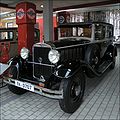
Audi Type SS (1930)
· 
Audi Type 920 (1939)
1932-1945: Audi and Auto Union AG, Chemnitz
In June 1932, the Zschopauer Motorenwerke (DKW) with its Zwickau subsidiary Audi, the Horchwerke AG (also Zwickau) and the Siegmar automobile plant of the Wanderer-Werke in Schönau near Chemnitz were merged to form Auto Union. The company logo with the intertwined rings symbolised the merger of the four brands, which nevertheless remained independent. After the new group was entered in the commercial register of the city of Chemnitz, Audi and Horch were liquidated as companies and the factories continued to operate as Auto Union AG, Horch plant and Auto Union AG, Audi plant respectively. Chemnitz had been specified as the headquarters of Auto Union when the company was founded. Only under this condition had the city of Chemnitz invested in the company with a share capital of 750,000 RM. Despite reminders, the head office remained in Zschopau at the DKW plant until 1936. It was not until 1936 that it was relocated to Chemnitz to the former Presto-Werke administration building. Due to the effects of the world economic crisis, far-reaching rationalisation measures were necessary in all Auto-Union plants. What initially began with the takeover by Zschopauer Motorenwerke (DKW) was now continued under the management of the main shareholder, the Sächsische Staatsbank.
The Horch cars combined prestige and tradition and had the highest market share in the luxury class in the German Reich of the 1930s with more than 50 %. In addition to its own luxury class vehicles, the Horch plant also built the Audi brand's mid-range cars, while the Audi plant produced the DKW "Frontwagen" for the volume segment. The Audi cars sold the smallest numbers of units - the Auto Union brands' share of total passenger car production in the German Reich in 1938: DKW 17.9 %, Wanderer 4.4 %, Horch 1.0 %, Audi 0.1 %.
1945-1968: Post-war period - dissolution, re-establishment and first post-war Audi
→ Main article: End of the Auto Union in Central Germany
After the Second World War, Auto Union AG, which was based in the Soviet occupation zone, was first confiscated by the Soviet Military Administration in Germany (SMAD) and then expropriated without compensation.
Hans Migotsch is regarded as the initiator of the reconstruction of the Audi plant in Zwickau after the Second World War. As a trustee, he obtained the release of the plant from the SMAD as early as September 1945. This release enabled machines to be assembled, derusted and repaired, and production to begin. As plant director, he was responsible for the later production of the IFA F 8 and the IFA F 9 and was significantly involved in the research of a replacement material for missing planking sheet.
The former VEB Audiwerk Zwickau (AWZ) produced the AWZ P 70 in 1957 after being renamed VEB Automobilwerk Zwickau. VEB AWZ was merged with VEB Sachsenring Kraftfahrzeug- und Motorenwerke Zwickau, the former Horch plant, to form VEB Sachsenring Automobilwerke Zwickau on 1 May 1958. The world's first small car with a plastic skin, the Trabant, was then produced here until 1991.
Since in the Trizone (West Germany) the four branches in Munich, Nuremberg, Hanover and Freiburg (Breisgau) were far too small for the production of vehicles due to their spatial possibilities, and all Auto Union plants except for the DKW plant in Berlin-Spandau were located in the Soviet zone, it was first decided to secure the DKW spare parts stock in the Auto Union Central Warehouse South in Ingolstadt. Auto Union thus had an advantage over other vehicle manufacturers in West Germany: the DKW cars had only been requisitioned to a limited extent by the Wehrmacht because of their two-stroke engines (DKW 4=8), the self-supporting bodies made of plywood and the front-wheel drive (DKW Frontwagen). In West Germany, more than 65,000 DKW cars of the Reichsklasse and Meisterklasse types were still in service after the end of the war. Even in other European countries there was still a considerable stock of vehicles. On this basis, the first steps were taken to rebuild Auto Union in West Germany by founding the Zentraldepot für Auto Union Ersatzteile GmbH from the former Zentrallager Süd. This meant that the remaining Auto Union vehicles could be supplied with spare parts immediately after the end of the war.
After Auto Union AG had been deleted from the Chemnitz Commercial Register in August 1948, the company no longer existed and could be re-established in 1949/1950 in the Federal Republic as Auto Union GmbH with its registered office in Ingolstadt.
Many employees from the former plants in Zwickau, Zschopau and Chemnitz left for Ingolstadt and initiated a rebuilding. All others were led by the former chairman of the board of the old Chemnitz Auto Union Richard Bruhn and his deputy Carl Hahn. The vehicles of the "new" Auto Union were again produced under the DKW brand in Ingolstadt (from 1949 DKW Schnelllaster) and in the former Rheinmetall plant in Düsseldorf-Derendorf (DKW F 89), which was initially leased. The Spanish subsidiary Industrias del Motor S.A. (IMOSA) built a new plant in Vitoria (Basque Country) in the early 1950s, which also produced DKW fast trucks from 1954.
In 1958, at the insistence of the main shareholder Friedrich Flick, Daimler-Benz AG took over 88 % of the share capital of the West German Auto Union GmbH. Between 1964 and 1966, Volkswagenwerk AG bought Auto Union GmbH and its Ingolstadt plant (the Düsseldorf and Vitoria plants in Spain remained with Daimler-Benz). VW also took over the rights to the logo with the four rings, representing the four brands Audi, DKW, Horch and Wanderer. Rudolf Leiding, previously head of the VW plant in Kassel, became the new managing director in Ingolstadt.
Demand for two-stroke cars had collapsed; some 30,000 new vehicles stood unsold in stock. To avert the collapse of the company, technicians worked on the Audi F103, which was to receive the medium-pressure engine developed by Daimler-Benz, a four-stroke gasoline engine with a compression ratio of over 11:1, which was between the usual values of a gasoline and diesel engine. In order to secure employment for the approximately 12,000 employees in Ingolstadt and to cover the development costs of the new car, a total of 347,869 VW Beetles were built in Ingolstadt from May 1965 to July 1969.
With the internally named F103, Auto Union launched the first passenger car of the "Audi" brand after the war in 1965. Initially, this was not given any further sales designation. It was not until the model range was expanded that the cars were given numbers corresponding to their engine output in horsepower (for example: Audi 60 and Audi Super 90). In 1968, former Daimler-Benz employee Ludwig Kraus presented the Audi 100, developed by Kraus without the knowledge of the Board of Management, to VW Chairman Heinrich Nordhoff. Nordhoff was enthusiastic about the development and agreed to production.
Since 1969: Merger with NSU and foundation of today's Audi AG
In 1969 Auto Union GmbH merged with NSU AG from Neckarsulm. The company was now called Audi NSU Auto Union AG and since then had a second plant and (until 1985) its headquarters in Neckarsulm. In January 1971, the slogan "Vorsprung durch Technik" was used for the first time, in a three-part series of double-page advertisements by Audi NSU Auto Union AG. After production of the Ro 80 ceased in 1977, the use of the NSU name as a product designation came to an end. Since 1 January 1985, Audi NSU Auto Union AG has been trading as Audi AG. At the same time, the company moved its headquarters from Neckarsulm to Ingolstadt. Since then, products and company have borne the same name.
Audi has also been active in Hungary since 1993. In addition to the assembly of the Audi TT, all engines are built in the Hungarian city of Győr.
From 2002, Audi, together with Seat and Lamborghini, formed the sport-oriented Audi brand group within the Volkswagen Group, alongside the Volkswagen brand group with VW, Škoda, Bentley and Bugatti. Both brand groups were dissolved again in 2007 on the initiative of Martin Winterkorn.
In 2005, Audi celebrated 25 years of quattro, and on September 30 and October 1, 2006, it celebrated 100 years of automobile manufacturing in Neckarsulm with an open day and the start of production of the Audi R8. Television and magazine commercials have won several awards, including some with cult status, such as the wobbly Elvis created by Audi or the commercial in which a Quattro-powered Audi drives up a snow-covered ski jump. In 2005, Audi began manufacturing its first SUV of its own, the Audi Q7. This lineup was later expanded to include the Audi Q5 (2008), Audi Q3 (2011), Audi Q2 (2016), and Audi Q8 (2018).
Contrary to the standard design with longitudinal engines, the smaller Q models do not have permanent all-wheel drive, but rather the more cost-effective all-wheel drive, which engages when required and is developed by Volkswagen, as an option. This drive, which Škoda and Seat also use, is also used by Audi in the A1 and A3 models.
In October 2011, the ten millionth vehicle in the Audi 80/A4 model series rolled off the production line; a red S4.
On April 18, 2012, Audi announced its intention to buy the Italian motorcycle manufacturer Ducati. It was hoped that this would generate synergies in the area of small, fuel-efficient engines and lightweight construction.
2020s: Conversion to electromobility
Since the beginning of the 2020s, Audi has been converting its product range to electromobility and focusing its product development on electrified models. By around 2026, 20 electric models are to be offered. In mid-March 2021, company CEO Markus Duesmann let it be known that the company was halting the development of another generation of gasoline and diesel powertrains. The EU plans for an even stricter Euro 7 emissions standard are a huge technical challenge with little benefit for the environment. This places extreme restrictions on the internal combustion engine. Therefore, no new combustion engine will be developed, but existing combustion engines will be adapted to the new emission guidelines.
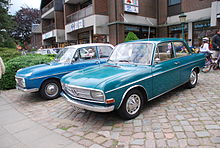
In the foreground an Audi F103, behind it the predecessor model DKW F102. Auto Union GmbH reintroduced the Audi name with the F103 series.

Logo until 2009
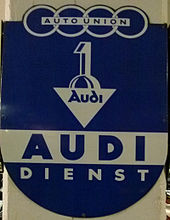
Audi logo under the Auto Union
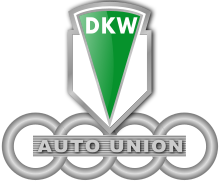
DKW logo - the four rings of Auto Union correspond to the four brands Audi, DKW, Horch and Wanderer

Commemorative plaque at the first company headquarters in Ingolstadt
Corporate structure, brands, subsidiaries
Following the transfer of shares held by minority shareholders on November 16, 2020, Audi is wholly owned by Volkswagen AG. The stock market listing was discontinued.
|
|
|
|
|
|
|
| ||||||||
|
| ||||||||||||||
|
|
|
|
|
|
|
|
|
|
|
| ||||
|
| ||||||||||||||
|
|
|
|
|
|
|
|
|
|
|
| ||||
|
| ||||||||||||||
|
|
|
|
|
|
|
|
| |||||||
|
| ||||||||||||||
|
|
|
|
|
|
|
|
|
|
|
| ||||
|
| ||||||||||||||
|
|
|
|
|
|
|
|
|
|
|
|
|
| ||
|
|
|
|
|
|
|
| ||||||||
|
|
| Lamborghini |
|
|
| |||||||||
|
| ||||||||||||||
|
|
|
|
|
|
|
|
|
|
|
| ||||
|
| ||||||||||||||
|
|
|
|
|
|
|
|
|
|
|
|
|
| ||
|
|
|
|
|
|
|
| ||||||||
| |
|
|
|
|
| |||||||||
|
| ||||||||||||||
Other divisions and investments
(as of February 21, 2021)
Services
- Audi Interaction GmbH - (100 % Audi subsidiary, since 2010)
Development services
- PSW automotive engineering GmbH - (100% Audi subsidiary, 91% in 2011, acquisition of the remaining 9% in 2016).
Real Estate
- AUDI Immobilien GmbH & Co. KG - (100 % Audi subsidiary)
- AUDI Immobilien Verwaltung GmbH - (100 % Audi subsidiary)
Mobility and digitalisation
- Audi Business Innovation GmbH - (100 % Audi subsidiary, since 2013)
- Silvercar, Inc. - (100 % Audi subsidiary, since March 2017)
Professional sport
- FC Bayern München AG - 8.33% (since July 2011)
- FC Ingolstadt 04 - 19.94% (via Audi Sport GmbH)
another
- Audi Stiftung für Umwelt GmbH - (100 % Audi subsidiary, since December 2009)
- Audi Events und Services GmbH - (100 % Audi subsidiary)
- Auto Union GmbH - (100 % Audi subsidiary, tradition maintenance of the brands: Auto Union, Horch, Audi, DKW, Wanderer and NSU, since 2011)
- There Holding B.V - 29.71% (since 2015)
- IONITY GmbH - (joint venture, since 2017)
- FAW-Volkswagen Automotive Co., Ltd. - 1 %
- Volkswagen Automatic Transmission (Tianjin) Co., Ltd - 40.07 %
- SAIC-Volkswagen Automotive Co., Ltd. - 1 %
Audi Sport GmbH
→ Main article: Audi Sport GmbH
Audi Sport GmbH is a wholly owned subsidiary of Audi AG. The company, which was called quattro GmbH until the end of 2016, was founded in 1983 and has been independent since 1996. Audi Sport is responsible for customizing every Audi model - not just sporty ones - according to customer wishes. Certain equipment packages are called S line, special finishes also Audi exclusive. The first independent project of the then quattro GmbH was the S6 plus, which was presented in March 1996. The company is based in Neckarsulm.
after tax results
- 2019: 3,943 million euros
- 2018: 3,463 million euros
- 2017: 3,479 million euros
- 2016: 2,066 million euros
- 2015: 4,297 million euros
- 2014: 4,428 million euros
- 2013: 4,014 million euros
- 2012: 4,349 million euros
- 2011: 4,440 million euros
- 2010: 2,637 million euros
- 2009: 1,347 million euros
- 2008: 2,207 million euros
Audi Sport logo
Search within the encyclopedia
